Are you looking for a DNA centimorgan chart? In this post, you'll find the best one out there so far. I'll explain how to use and understand the chart, too!
Without access to a chart that helps us estimate our relationship to our DNA matches based on shared DNA, we would have a difficult time making sense of our DNA match list. A chart is a crucial part of understand our DNA matches, and it is very handy to have as a reference.
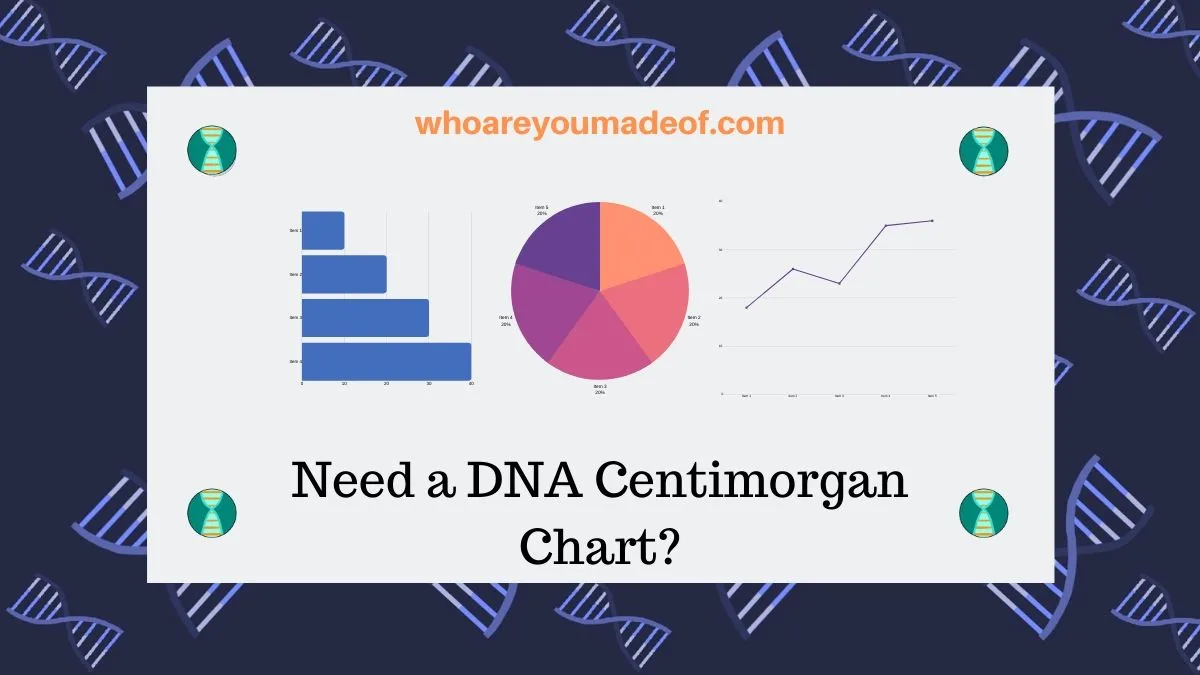
The best DNA Centimorgan relationship chart
The best DNA centimorgan chart available to us is shown below. It was developed by Blaine Bettinger (find his blog here), created from input submitted about more than 60,000 relationships.
It is basically like a cousins chart with centimorgans added for extra bonus. The graphic includes relationships as close as parent/child, and has data for DNA shared between cousins as distant as 8th cousin.
In other words, it is a chart based on comprehensive user-submitted data, and is useful to anyone who wants to know how they might be related to their DNA match. Sometimes, it can be challenging to figure out how we are connected to a genetic relative, especially when we don't have very much family tree information.
By knowing the relationship possibilities based on the number of shared centimorgans, which is sometimes abbreviated as "shared cMs", we can narrow down the search a bit.
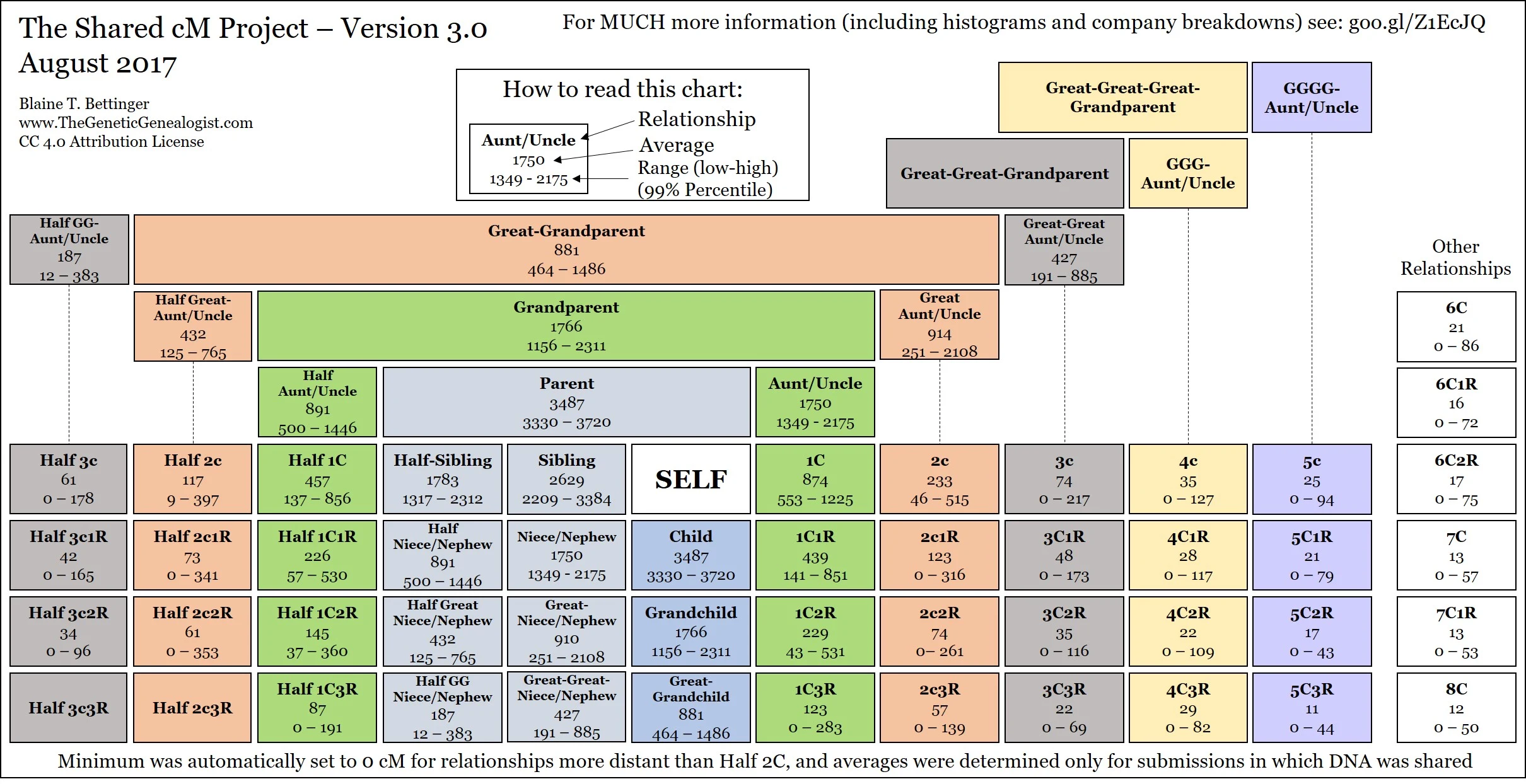
For best viewing, you can download the chart to your computer or phone here:
This DNA centimorgans chart can help us with matches from AncestryDNA and 23andMe, as well as matches from any other DNA testing company that provides the amount of centimorgans we share with our DNA relatives.
How to understand the DNA centimorgan chart
When you have a DNA match you are trying to research, the first thing that you should do is find out how much DNA you share, expressed in centimorgans. For this process, you might want to know that centimorgans are abbreviated using the letters "cM".
This total number of cMs shared always includes at least one shared DNA segment. We can share a single DNA segment with a match, or dozens, and the total length of all of those shared segments added together is the total number of cMs that we share with our match.
Once you know how many centimorgans you share with your match, you can then examine the DNA relationship chart to find all of the relationship possibilities for that amount of shared DNA. There is almost always more than one relationship possibility for any given amount of shared DNA.
Sometimes, there are many!
As an example, let's take a a match that shares 217 cMs with you. We can look at the chart below, where I've circled in red each relationship that has a range of shared DNA that includes 217 cMs, that there are technically 19 possibilities:
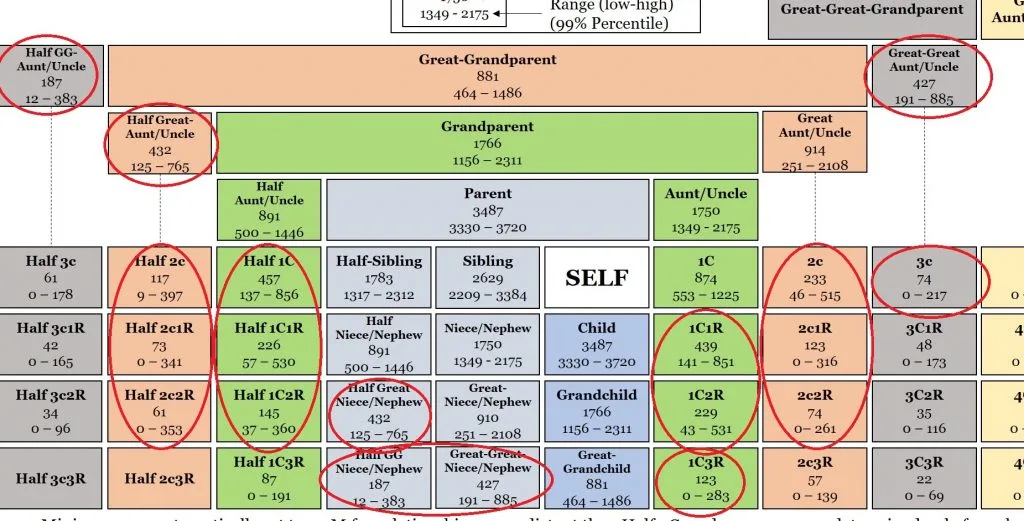
Use logic and information and yourself and your match to eliminate possibilities
Nineteen relationship possibilities! That's way too many!
There is an easy way to exclude some of these, so don't worry. After you cross a few possibilities off of the list, you can use the family tree information that you do have to make more sense of your connection to your relative.
Use genealogical data to decide on a few, or several possibilities
If you have access to your DNA match's family tree or have contacted them and know some of the surnames in their pedigree, you can use this information to help determine which lines of the family they might be on.
Exclude some possibilities using age
For example, you'll notice that two of the relationships would be elders in your family. If you know that your DNA match is younger than you, then you could cross the following relationships off your list:
- Great-great aunt or uncle
- Half-great-great aunt or uncle
- Half-great aunt or uncle
If you know for sure that you don't have any full siblings, you could exclude great-great niece or nephew from the list. This still leaves us with fifteen possibilities, but still don't start worrying!
Exclude other possibilities using data points from your close relatives
If your sibling, parent, aunt, uncle, or cousin has tested, see if you can find out how much DNA they share with the match you are researching. If you can, you can use this data to further exclude a relationship possibility.
Using our example, if we know that your father shares 625 cMs with the match, we can eliminate many of the fifteen relationship possibilities. The only thing that you must keep in mind is that your match will have a slightly different relationship to your relative than they do to you (unless your relative is your sibling).
If we exclude the too-young and the too-old matches, just for the sake of moving things along, we see that we are most likely looking at just a few relationship possibilities! This is significantly better than 19!
Use shared matches to narrow possibilities down even further
So, how do we decide between the three-ish options we have left? Fortunately, we still have some tools at our disposal.
One things that you could do is see examine the matches that you share in common with your DNA match. By finding close relationships that also match your DNA match, you can exclude them from being descended from some of your ancestors.
By knowing which ancestors your match is or isn't descended from, you can narrow things down considerably.
If you notice that your father shares DNA matches that you know to be from both sides of his family, like first or second cousins related to either of your grandparents, you can exclude half-first cousin. If your match is related to both sides of your father's family, then you can be sure that they are descended from both of your father's grandparents.
Is the DNA centimorgan chart 100% accurate?
The DNA relationship chart that I included in this post is, by far, the most helpful chart that is available to the public at this point in time. Even so, there are some important details that everyone should understand about the data collected and included for development of the chart.
It should also be noted that the estimated relationship that is provided by your DNA testing company is also an excellent guide that you can use to help determine your relationship to your match.
The data for the cM DNA chart was self-reported
The data used for collection of the chart was collected from tens of thousands of people who entered their relationship and shared DNA amounts into data collection form.
It's important to understand that there are many ways in which the data reported might not be 100% accurate. Blaine Bettinger, the blogger and DNA expert who created the chart, excluded extreme outliers in order to prevent incorrect data from skewing the results, of course.
Even so, the chart is best used in conjunction with good genealogy research and other DNA analysis.
Endogamy causes multiple relationships and can skew shared DNA
Some of us are related to our DNA matches in more than one way, and it is usually a sign of endogamy. Sometimes, it isn't even possible to know this or know how many ways we are related to the same person.
For example, we might have a 5th cousin who shares 4th great-grandparents with us. This same cousin might also be a third cousin twice-removed on a different line of the family, and could even be related to us in a completely different way on a third line of our family tree.
This occurs most often in people who are descended from a common, endogamous founding population. The result of this is that distant cousins might share multiple DNA segments with each other inherited from all of the common ancestors on different lines.
This can make the expected range of shared DNA for distant cousins higher than it really should be. There isn't anything to be done, really, about this, but it's good to know when viewing the DNA chart.
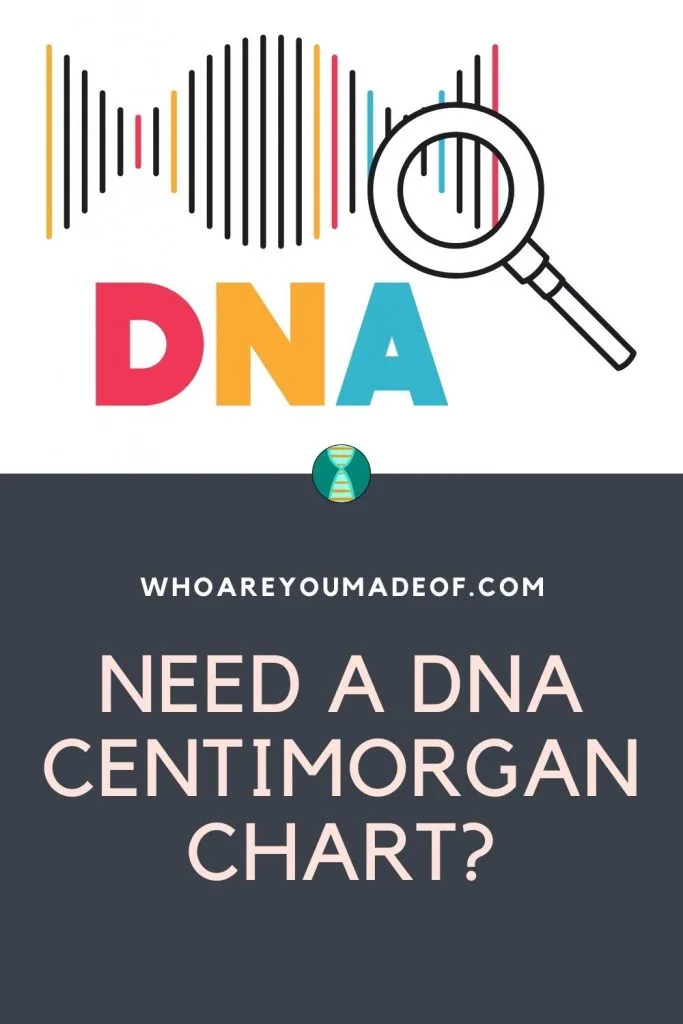
Conclusion
I hope that you enjoyed finding this DNA chart to help you understand your relationship to your matches, and that you understand how to use it. If you have any questions about something that you read in this post, or if you would like to share your own experience using the chart, I would love to hear from you in the post below.
Thanks for stopping by today!

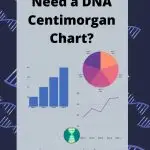

Jim Ward
Sunday 2nd of June 2024
Great chart, easy to understand. But the problem is that three-quarters (usually more) of the potential cousins we message don't respond. I have been noting matches on chromosomes on a spreadsheet and hope someday to say yes, that match is to a specific line. Then I learned about IBC. Sigh.
Annie H
Friday 16th of June 2023
Hi. I have hit a ‘brick wall’ searching for my father in laws father. He was born ‘illegitimate’ and father was named on his birth certificate. 2 DNA matches are quite close, but as I don’t have ‘a name’ to guide me, I am finding it a maze to try and work things out. 1 of the close matches, call him G, is also intrigued, as there is a sizeable amount of ‘Jewish’ showing up in both my husband and G’s heritage. The DNA relationship between husband and G, from Ancestry are 2nd – 3rd Cousin | Paternal side 4% shared DNA: 285 cM across 10 segments Unweighted shared DNA: 285 cM Longest segment: 86 cM Husband Ethnicity inheritance England & Northwestern Europe Paternal 26% Maternal 46% Husband 72% Jewish Paternal 22% Maternal 0% Husband 22%
G Ethnicity inheritance England & Northwestern Europe Maternal 11% Paternal 20% G 31% Jewish Maternal 0% Paternal 25% G 25% Wales 16% 5% 21% Scotland 13% 0% 13% Norway 8% 0% 8% Ireland 2% 0%. 2%
There is another individual , who is common to both of them, but we cannot work out who is the common denominator R to my husband 2nd – 3rd Cousin | Paternal side 2% shared DNA: 133 cM across 7 segments R to G 2nd – 3rd Cousin | Parent 2's side 2% shared DNA: 105 cM across 8 segments
R Ethnicity Estimates 95% England nd Northwest Europe 5% Scottish No Jewish
Please can you help me. Thank you for your fantastic resources. Annie
Sandra Dodd
Monday 12th of December 2022
I am 78 years old and trying to figure out this cm and segments DNA information. Though I didn't believe I was stupid I find all of this totally beyond my understanding. I am an adoptee and had a DNA done. On it, as I know birth Mother's name, I found a match with 1730 cm with 58 segments. Am I correct that this could well be an Uncle on paternal side as no one on birth Mother's side has that last name that was listed. Thank you for any enlightenment you can give.
Nicola
Thursday 26th of January 2023
I think you are saying you found a male match with a last name that is not from your mother's side. And you know this because your birth mother is on this site with her family names listed. 1730 is a strong family relationship, but it helps to take age into account to figure out what that relationship might be. Do you think this match is the right age to be an uncle, rather than say a half-sibling or a nephew? It is common for adopted persons to have relatives that are "half", meaning half-sibling etc.
M. Chase
Saturday 20th of August 2022
I have the following close matches: a First Cousin that has 1853 cM (27% shared DNA with me) and someone who I did not know was a relative of me that has 1,498 cM (21% shared DNA) with me. I used Bettinger's Genealogical chart to look for the most logical match. I am 70 years old and the individual that shares 1,498 cM with me is 35 years old. He seems to fall in the range of a nephew...but not one that the family knows about. Could he be a First Cousin (as Ancestry.com says, even though the cM range for a First Cousin on the chart is only 553 cM to 1,225 cM) or could he be a Half-nephew (which the chart shows ranges from 500 cM to 1,446 cM)?
Are the ranges of cM on Bettinger's chart 100% accurate? What % accuracy would those ranges have?
Clay Price
Sunday 28th of March 2021
Thanks for this great resource, Mercedes, and the extended explanation of how to use DNA to determine relationships. This is very helpful. At the same time I regret my grandparents and parents are no longer living in order to achieve a greater understanding of our family connections (and heritage for that matter). I'm a latecomer to the topic of DNA.